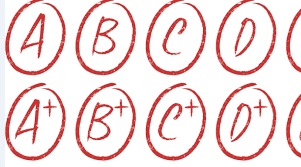To B or not to B...Is that Really the Question?
These two anecdotes are true, except for the grade part, of course. When it comes to our health and our finances, we expect a whole lot more than a single letter to communicate what’s working and what needs work.
And this is the purpose of proficiency-based grading: to convey to learners, their families, and others what a single grade cannot--the learners’ current level of performance with each of the specific performance criteria used to determine the grade.
But the power of the single-letter grade should not be underestimated. It enables us to quickly evaluate a performance, be it a movie, a math test, or a meal (“I’d give that burrito a C+”). Moreover, the A to F model runs deep in our culture, a longstanding and potent meme.
The fatal flaw of conventional grades--their subjectivity and the lack of clarity about what they represent--can be remedied without getting rid of grades. I’d be okay with my doctor or my financial advisor using a letter grade to begin a conversation with me about my health or my investments. Kind of handy. But then I’d expect them to unpack that grade, help me understand how I can improve my physical health and my financial prospects.
Single-letter grades can work just fine in schools, when they are backed by explicit, predetermined performance indicators. Without these kinds of metrics, the fields of medicine and finance--and most professions--would be ineffective, at best, and at worst, corrupt.
So too with education.
Conventional grading practices--in which teachers use their own formulas for calculating grades via a 100 point scale--muddy the learning process. This subjective and shape-shifting approach incentivizes students to game each teacher’s point system, rather than engage in ongoing discussions about their progress towards explicit learning outcomes.
So let’s cut Vermont educators and schools some slack as they work out how to grade and report learning in more meaningful ways.
And let’s celebrate how these conversations are already shifting how educators talk with each other and their students about learning. How is the way we’re assessing and instructing impacting learning? Are we really teaching what matters most? And most important of all: How can we get all students at the table, developing and managing their learning portfolios, in ways that make school increasingly relevant and meaningful to their lives?
While there’s still much work and learning to be done, the ambitious and complementary visions of Act 77 and Vermont’s Education Quality Standards (EQS) are beginning to bear fruit. Let’s savor the sweetness and stay the course.

Thanks for sharing Bill. Love the analogy
ReplyDeleteThank you Bill. As always I enjoy hearing your thoughts about teaching and learning. We are in the first iteration of a monumental shift. We must stay focused on why we are shifting and for whom.
ReplyDeletePerfectly put. I'm not in Vermont but THIS needs to be a discussion everywhere. I may even share this with my students to help them understand why I use my stadards-based system. Thank you.
ReplyDeleteThis is a great way to help people understand the work we're doing. Thank-you!
ReplyDelete